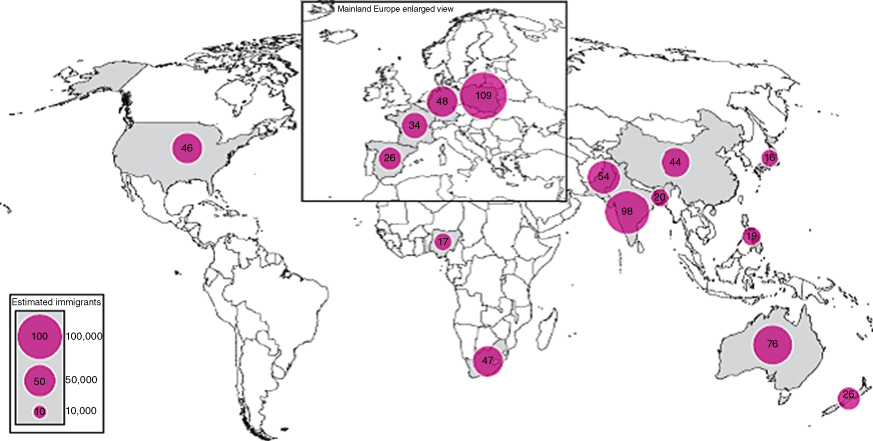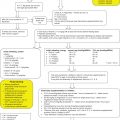Chapter 27
Children from Ethnic Groups and those following Cultural Diets
Eulalee Green
Introduction
The UK is the home to a multicultural and multi-ethnic society. Immigration during the late 1950s and early 1960s was in response to labour shortages. Since the 1980s conflict in Africa and Europe has led to further immigration and, together with movement of people from newly joined European Union countries, the diversity of the UK has increased. As with the early migrations, ethnic communities have remained near large industrialised cities. These ethnic groups have introduced a wide variety of cultures, including dietary beliefs and practices, which have had to fit into their new lifestyles. Achieving nutritionally adequate diets became a challenge with people finding themselves in an environment very different from their homeland.
The top 15 countries of last residence of migrants to the UK in 2005–2006 are shown in Fig. 27.1 and Table 27.1. Table 27.2 shows the percentage of ethnic groups in England and Wales in 2011.

Figure 27.1 Immigrants to the UK in 2005–2006: top 15 countries of last residence.
Source: Office of National Statistics [1].
Table 27.1 Top 15 countries of last residence of all migrants 2005–2006 combined
| Ranking | Country of last residence | Thousands of immigrants |
| 1 | Poland | 109 |
| 2 | India | 98 |
| 3 | Australia | 76 |
| 4 | Pakistan | 54 |
| 5 | Germany | 48 |
| 6 | South Africa | 47 |
| 7 | USA | 46 |
| 8 | China | 44 |
| 9 | France | 34 |
| 10 | New Zealand | 26 |
| 11 | Spain | 26 |
| 12 | Bangladesh | 20 |
| 13 | Philippines | 19 |
| 14 | Nigeria | 17 |
| 15 | Japan | 16 |
Source: Office of National Statistics [1].
Table 27.2 Percentage of ethnic groups in England and Wales, 2011
| Percentages | |||
| Total population | Ethnic population | ||
| White | White British | 80.5 | |
| Irish | 0.9 | 4.6 | |
| Gypsy or Irish traveller | 0.1 | 0.5 | |
| Other White | 4.4 | 22.5 | |
| Mixed/multiple ethnic groups | White and Black Caribbean | 0.8 | 4.1 |
| White and Asian | 0.6 | 3.1 | |
| White and Black African | 0.3 | 1.5 | |
| Other mixed | 0.5 | 2.6 | |
| Asian/Asian British | Indian | 2.5 | 12.8 |
| Pakistani | 2.0 | 10.3 | |
| Bangladeshi | 0.8 | 4.1 | |
| Chinese | 0.7 | 3.6 | |
| Other Asian | 1.5 | 7.7 | |
| Black/African/Caribbean/Black | African | 1.8 | 9.2 |
| British | Caribbean | 1.1 | 5.6 |
| Other Black | 0.5 | 2.6 | |
| Other ethnic group | Arab | 0.4 | 2.1 |
| Any other ethnic group | 0.6 | 3.1 | |
Source: Office of National Statistics [2].
Infants and children of any age have special dietary requirements. It is therefore essential that healthcare professionals understand religious and cultural attitudes towards diet when they are initiating any dietary intervention, in order to achieve optimal growth and development in these children. Assessment of intake must be accurate and any advice given must be relevant to dietary custom so that it is both realistic and achievable.
Children are subject to many outside influences and often start to develop westernised dietary ideas. With time, these ideas are taken home and adopted by other members of the family. The extent of adoption of dietary practices which differ from traditional customs is variable; therefore all diets must be individually assessed.
Table 27.3 shows the religions practised in the UK and Table 27.4 gives a guide to religious and cultural influences on the diet.
Table 27.3 Percentage of the UK population belonging to a religion, April 2011–March 2012
| Religion | Population percentage | Number (thousands) |
| Christian | 62.0 | 37 191 |
| Islam/Muslim | 4.6 | 2755 |
| Hindu | 1.4 | 860 |
| Sikh | 0.6 | 350 |
| Jewish | 0.5 | 287 |
| Buddhist | 0.4 | 246 |
| None or undeclared | 29.9 | 17 927 |
Source: Office of National Statistics [2].
Table 27.4 A guide to religious and cultural influences on diet
| Food | Buddhist | Christian | Hindu | Jewish | Muslim | Rastafarian | Seventh Day Adventist | Sikh |
| Eggs | Acceptable to some | Acceptable | Acceptable to some | No blood spots | Acceptable | Acceptable to some | Acceptable to most | Acceptable |
| Milk, yoghurt | Acceptable | Acceptable | Acceptable to some | Acceptable | Acceptable to some | Acceptable to some | Acceptable to most | Acceptable |
| Cheese | Acceptable | Acceptable | Not with rennet | Not with rennet | Not with rennet | Acceptable to some | Acceptable to most | Acceptable to some |
| Pork | Acceptable to some | Acceptable to most | Rarely acceptable | Not acceptable | Not acceptable | Not acceptable | Not acceptable | Rarely acceptable |
| Beef | Acceptable to some | Acceptable | Not acceptable | Kosher | Halal | Acceptable to some | Acceptable to some | Not acceptable |
| Lamb | Acceptable to some | Acceptable | Acceptable to some | Kosher | Halal | Acceptable to some | Acceptable to some | Acceptable |
| Chicken | Acceptable to some | Acceptable | Acceptable to some | Kosher | Halal | Acceptable to some | Acceptable to some | Acceptable to some |
| Fish | Acceptable to some | Acceptable— some only fish with fins and scales | Acceptable— with fins and scales | Acceptable— with fins, scales and backbone | Acceptable— with fins and scales | Acceptable— with fins and scales | Acceptable— with fins and scales | Acceptable to some |
| Shellfish | Not acceptable | Acceptable to most | Acceptable to some | Not acceptable | Acceptable to some | Not acceptable | Not acceptable | Acceptable to some |
| Animal fats | Acceptable to some | Acceptable | Acceptable to some | Kosher | Halal | Acceptable to some | Not acceptable | Acceptable to some |
| Alcohol | Not acceptable | Acceptable to most | Not acceptable | Acceptable | Not acceptable | Not usually wine | Not acceptable | Acceptable |
| Cocoa, coffee, tea | Acceptable | Acceptable | Acceptable | Acceptable | Acceptable | Not acceptable | Decaffeinated are suitable | Acceptable |
| Fasting | Good Friday and Ash Wednesday | 3 days a year or 1–2 days every week | Yom Kippur 1 day of atonement (no food or liquid for 25 hours) | Ramadan 1 month fasting (no food or liquid during daylight) | ||||
| Other comments | Most Buddhists are vegetarians or vegans, although some may not be | Certain foods are taken during prayers. Some Hindus may be vegetarians or vegans (Jains) | Kosher (food fit to eat), i.e. meat from animals slaughtered by a Kosher butcher Meat and dairy products are not consumed within 3 hours of each other | Halal, i.e. the meat must be from animals that have been bled to death and the phrase ‘in the name of God’ is said | Processed, preserved or tinned foods may be avoided. Most only eat Ital foods, i.e. in a whole and natural state No fruits of the vine, e.g. sultanas, grapes, currants | Some are vegetarians | Some are vegetarians | |
| Black and minority ethnic groups | Chinese, Vietnamese | Afro-Caribbean, Chinese, Greek, Greek Cypriot, Ugandan, Vietnamese, West African (e.g. Nigerian and Ghanaian), Indian | Gujarati, Punjabi, Indian | Jews of all nationalities | Arab, Bangladeshi, Pakistani, Gujarati, Somali, Turkish, Turkish Cypriot, Ugandan, West African (e.g. Nigerian and Ghanaian), Indian | Afro-Caribbean | Afro-Caribbean | Indian |
Source: Adapted from British Dietetic Association Community Nutrition Group [3].
Vegetarian and vegan diets
Vegetarianism and veganism are common dietary practices among many religious and ethnic groups. In addition, increasing numbers of the indigenous population are restricting their intake of meat and animal products for either humanitarian, ethical or health reasons. Table 27.5 gives a classification of vegetarian and vegan diets. Providing careful attention is given to ensuring nutritional adequacy, these diets will support normal growth and development [4–6]. In general the greater the degree of dietary restriction, the greater is the risk of nutritional deficiency [7]. The vegan diet is most restricted; Table 27.6 gives dietary sources of the nutrients most at risk.
Table 27.5 Classification of vegetarian and vegan diet
| Foods excluded | Animal protein source | Non animal protein source | Nutrients at risk of deficiency | |
| Partial vegetarian | Red meat | Poultry | Beans | Iron |
| Offal | Fish | Pulses | ||
| Milk | Nuts | |||
| Cheese | Seeds | |||
| Yoghurt | ||||
| Eggs | ||||
| Lacto-ovo vegetarian | Red meat | Milk | Beans | Iron |
| Offal | Cheese | Lentils | ||
| Poultry | Yoghurt | Nuts | ||
| Fish | Eggs | Seeds | ||
| Lacto vegetarian | Red meat | Milk | Beans | Iron |
| Offal | Cheese | Lentils | Vitamin D | |
| Poultry | Yoghurt | Nuts | ||
| Fish | Seeds | |||
| Eggs | ||||
| Vegan | Red meat | Beans | Protein | |
| Offal | Lentils | Energy | ||
| Fish | Nuts | Iron | ||
| Poultry | Seeds | Fat soluble vitamins | ||
| Eggs | Vitamin B2 | |||
| Milk | Vitamin B12 | |||
| Cheese | Calcium | |||
| Yoghurt | Zinc |
Table 27.6 Sources of nutrients at risk of deficiency in a vegan diet
| Nutrient at risk of deficiency | Suitable dietary alternative sources |
| Protein | Pulses (soya, tofu, tempeh, beans and lentils), grains (wheat, rice, rye, millet), seeds, groundnuts*, nuts* and nut spreads*. Meals should have a combination of grains with seeds or grains with pulses to get the right balance of essential amino acids |
| Energy | Vegetable oils/margarines, ground nuts*, nut spreads* |
| Iron | Iron fortified breakfast cereals, wholegrain cereals, wholemeal bread, pulses, dried fruit, nuts*. Dark leafy green vegetables are not a good source of iron for infants and young children as the portion size is so large (120 g for 2 mg iron). Foods rich in vitamin C, such as fruits and vegetables, aid the absorption of non animal sources of iron |
| Fat soluble vitamins | In England, white Caucasians will make enough vitamin D for the year from 30 minutes/day of moderate sunlight exposure from April to October. Black and Asian people living in England will not make enough and must rely on dietary sources or supplements: vegetable oils/margarines, fortified soya milk and fortified breakfast cereals |
| Essential fatty acids | Whole grains, nuts, seeds and seed oils |
| Vitamin B2 | Wheat germ, almonds, green leafy vegetables, yeast extract (e.g. Marmite, Tastex†), avocado, soya beans, fortified soya milk |
| Vitamin B12 | Fortified yeast extract (e.g. Marmite, Tastex†), fortified cereals, fortified soya milk, tofu |
| Calcium | Fortified soya products (milk and yoghurt), seaweed products (kombu, wakame, nori), nuts* and seeds. Other sources (bread, leafy green vegetables, pulses) are not good sources of calcium for infants and young children as the portion size is so large (>120 g for 100 mg calcium) |
| Zinc | Some soya products (flour, miso, cheese and tempeh), nuts*, seeds, wheat germ, wholemeal bread, fortified breakfast cereals, seaweed and hard cheeses |
| Iodine | Whole grains, seaweeds and vegetables |
* Nuts should be introduced with care if there is history/evidence of nut allergy and nuts should not be given to children under 2 years of age unless finely ground due to choking risk.
† Yeast extracts should be used with care in children under 2 years of age due to the high salt content.
Infant feeding
The current recommendation is for infants to be exclusively breast fed until 6 months of age. Solids should be introduced at around 6 months of age; breast feeding should be continued during this time [8]. There is a higher proportion of women from minority ethnic groups who choose to breast feed their babies up to 6 months (Table 27.7).
Table 27.7 Prevalence of breast feeding at ages up to 6 months by mother’s ethnicity in Great Britain, 2010
| Total Great Britain | White | Mixed | Asian or Asian British | Black or Black British | Chinese or other ethnic group | |
| % | % | % | % | % | % | |
| Birth | 82 | 79 | 87 | 96 | 95 | 96 |
| 2 days | 77 | 75 | 81 | 88 | 90 | 94 |
| 3 days | 75 | 73 | 80 | 86 | 90 | 93 |
| 4 days | 73 | 71 | 80 | 85 | 90 | 93 |
| 5 days | 72 | 69 | 79 | 84 | 90 | 93 |
| 6 days | 71 | 68 | 79 | 83 | 90 | 93 |
| 1 week | 70 | 67 | 79 | 83 | 90 | 92 |
| 2 weeks | 66 | 63 | 79 | 81 | 89 | 87 |
| 6 weeks | 56 | 52 | 75 | 73 | 85 | 82 |
| 4 months | 43 | 39 | 60 | 58 | 73 | 76 |
| 6 months | 35 | 32 | 49 | 49 | 61 | 66 |
Source: Data.Gov.UK [9].
All breast fed infants and infants having less than 500 mL of infant formula should be given a vitamin D supplement which should continue until 5 years of age [10]. Suitable vitamin drops include Healthy Start, Abidec and Dalivit (Table 1.22).
If the infant is not breast fed an infant formula must be given. Table 27.8 shows normal infant formulas and special therapeutic formulas which are suitable for vegetarian and vegan families and for those who require a Halal formula. Some families will accept ‘unsuitable’ formulas if there is a clinical need.
Table 27.8 Infant formulas suitable for Halal, vegetarian and vegan diets
| Cow’s milk based formulas | Suitable for Halal | Suitable for vegetarian |
| Abbott Similac | X | √ |
| Cow & Gate First Infant Milk | √ | X |
| Cow & Gate Infant Milk for Hungrier Babies | √ | X |
| Cow & Gate Follow-on Milk | √ | X |
| Milupa Aptamil First Infant Milk | √ | X |
| Milupa Aptamil Hungry Milk | √ | X |
| Milupa Aptamil Follow-on Milk | √ | X |
| Milupa Aptamil Growing-up (1+) | X | √ |
| Milupa Aptamil Growing-up (2+) | X | √ |
| SMA First Infant Milk | √ | X |
| SMA Extra Hungry Infant Milk | √ | √ |
| SMA Follow-on Milk | √ | √ |
At the time of printing, there were no formulas suitable for vegan diets. In addition, there were no amino acid, peptide or soya based infant formulas that were suitable for Halal, vegetarian or vegan diets, based on their ingredients. However, some manufacturers have statements to the effect that their formula is acceptable for certain cultural and religious groups—check with the manufacturer.
Some vegetarian families choose to give their babies goat’s milk or ewe’s milk in the belief that these confer health benefits and are preferable to cow’s milk. These milks are contraindicated because of their nutritional inadequacy, high renal solute load and doubtful microbiological safety [11, 12]. The European Food Safety Authority considers that protein from goat milk can be suitable as a protein source for infant formula provided the formula complies with the compositional criteria laid down in Directive 2006/141/EC [13]; however, goat’s milk formula has no health benefits over normal infant formulas.
Providing the maternal diet is adequate, breast milk will be nutritionally adequate for the first 6 months of life for most infants. Specific attention must be paid to the mother’s vitamin D, calcium and iron intakes. Vegan mothers may require supplementation with additional vitamin B12 [11]. Vitamin B12 deficiency resulting in neurological damage [14], irritability, faltering growth, apathy, anorexia and developmental regression has been reported in breast fed infants of vegan mothers [12]. Some algae (e.g. spirulina) and seaweeds (e.g. nori) contain natural compounds that are similar to vitamin B12; however, the human body cannot use these nutrients. Furthermore, because they are so similar to B12 they compete with it and can be the cause of B12 deficiency in people who do not eat animal products. Vegetarian sources of iron and vitamin B12 are given in Table 27.9.
Table 27.9 Sources of iron and vitamin B12 suitable for vegetarians
| Source | Iron mg | B12 µg |
| Infant formula, 200 mL | 1.4 | 0.4 |
| Milk (all types except UHT), 200 mL | 0.06 | 1.8 |
| Yoghurt full fat (1 medium pot), 150 g | 0.15 | 0.3 |
| Cheddar type cheese (1 slice), 40 g | 0.12 | 1.0 |
| Fromage frais (1 medium pot), 100 g | 0.06 | 0.5 |






